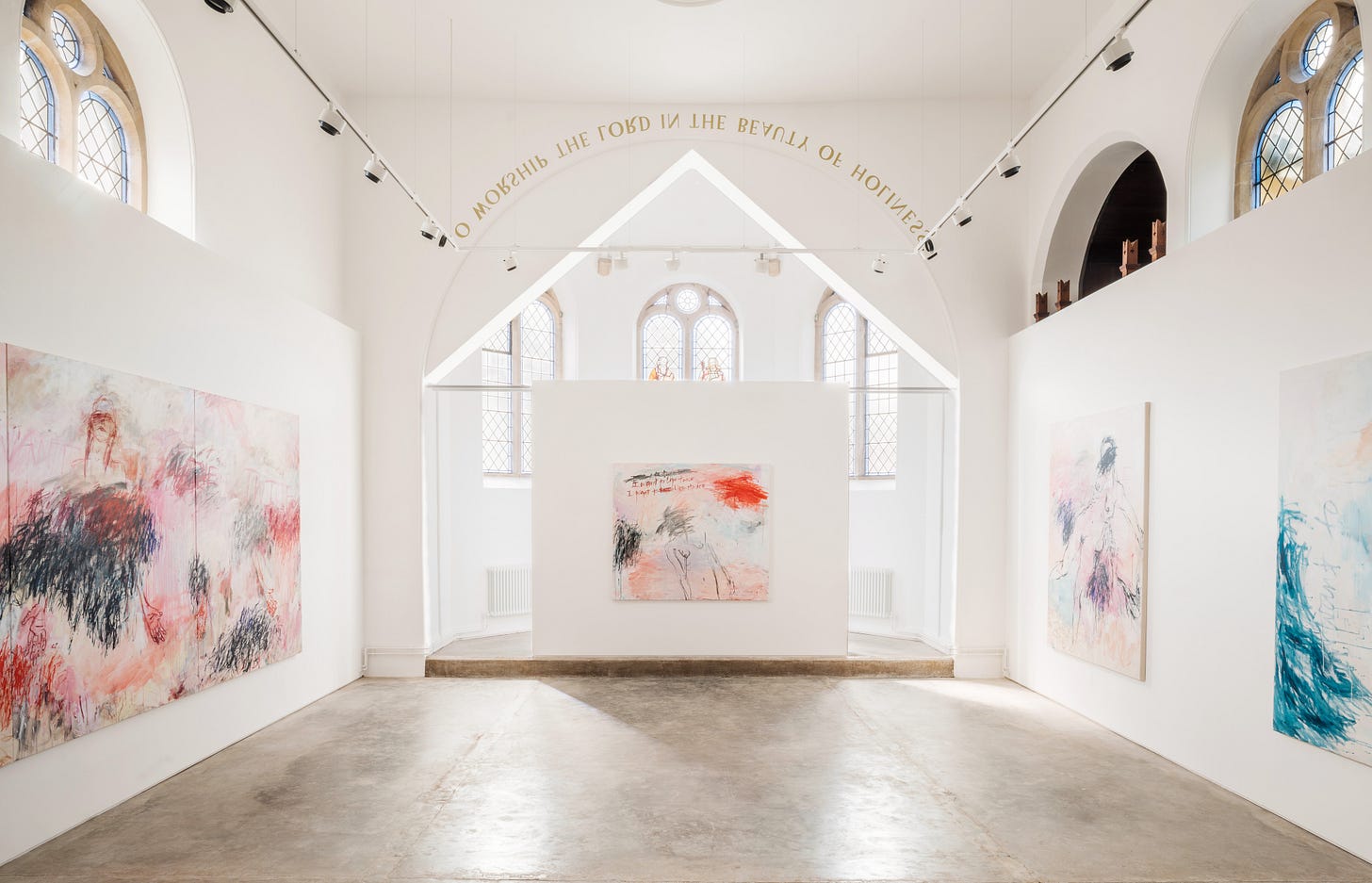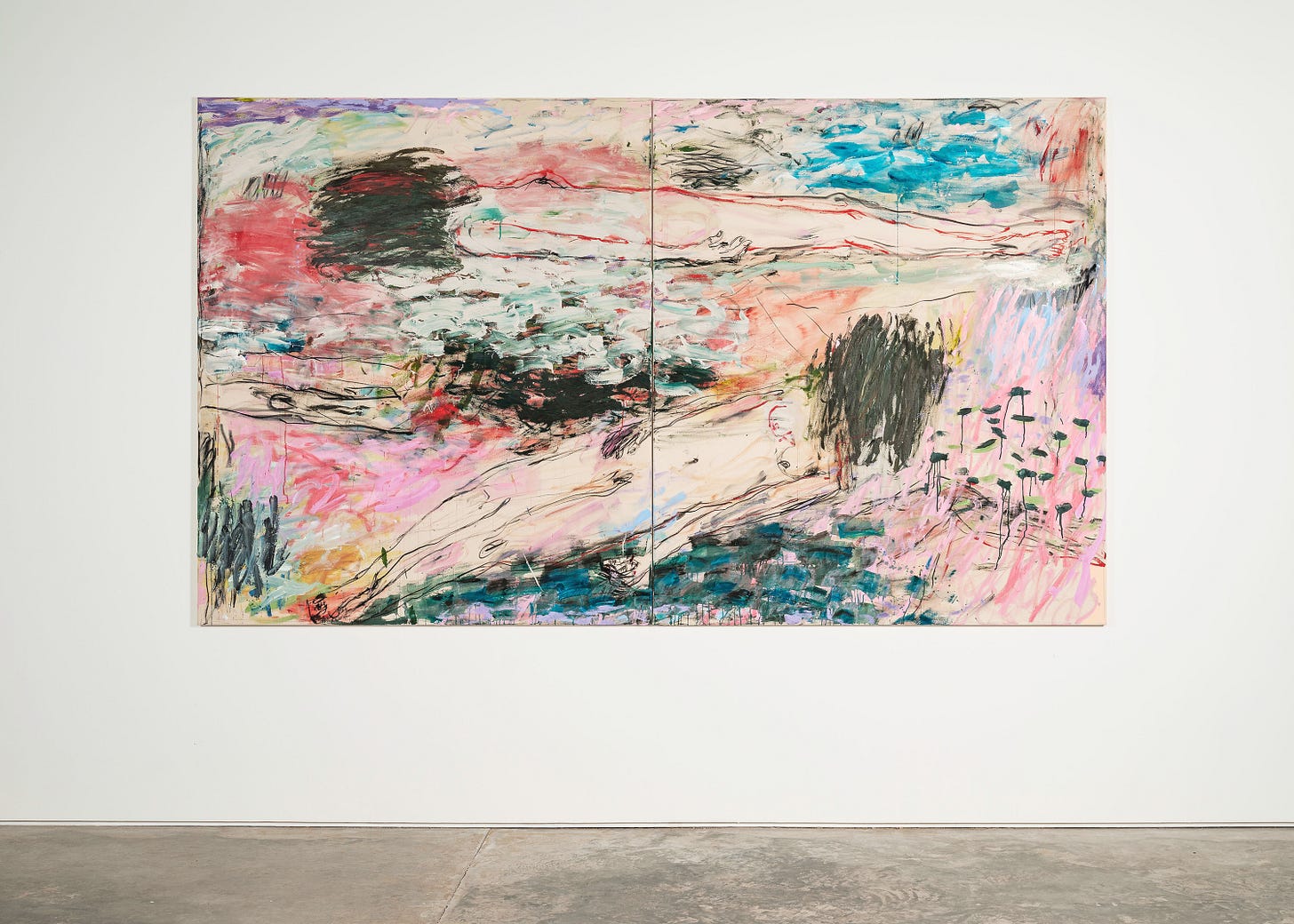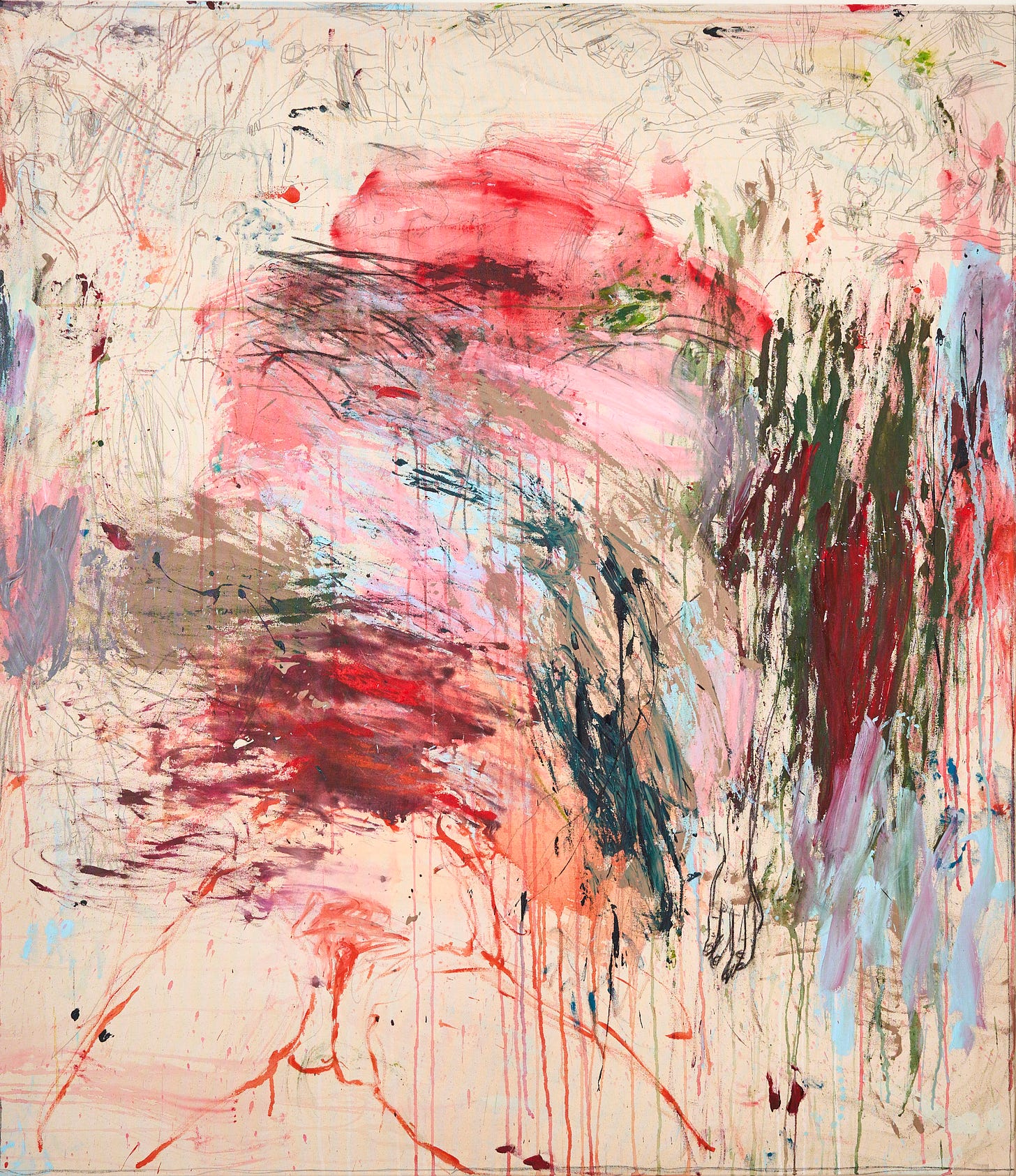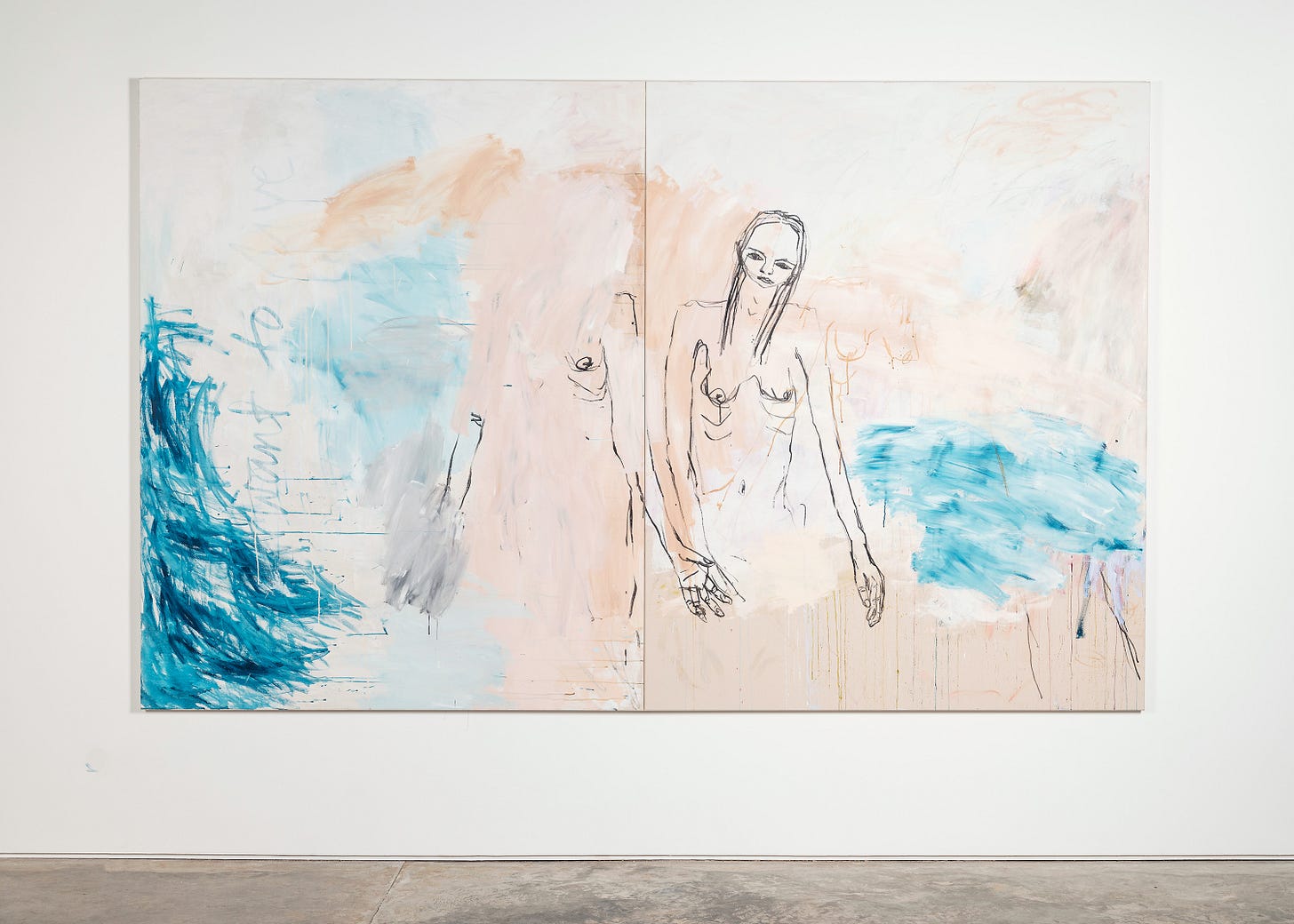The Wonderfully Loose Figurative Paintings of Kim Booker
As an abstract painter, I’m quite picky when it comes to figurative works. I’m really drawn to loose styles of figuration, whether it’s the joyously primitive paintings of Rose Wylie, the free flowing lines of Tracey Emin, or the swirling gestures of Cecily Brown. I’m drawn, I suppose, to what people call abstract figuration.
That looseness is also what caught my attention in the work of Kim Booker, a British artist whose paintings aren’t weighed down by their figures. Her expressive mark-making plunges the female figures into a cloud of chaos, as if lost in a confusing world that she’s attempting to make sense of. For me, it’s the ambiguity that keeps me on my toes as a viewer, keeps me noticing new things, with her frenzied marks offering a feast for the eyes.
I felt there was something soulful behind her painterly works, with themes of loneliness and isolation creeping into the frame. I reached out to Kim, who’s currently based in London, to learn more about her practice.
Hey Kim. What can you say about the female figures in your work?
The figures in my work are this kind of mute figure that’s repeated. They’re about trying to make sense of a world that often doesn’t make sense, and to come to terms with myself, to get some resolution around a sense of self and a sense of one’s place - in painting and more generally.
In all my paintings I’m trying to learn and to figure something out, whether that’s on a technical level or a more personal or philosophical level. I want total freedom but I don’t know if that’s possible. You are limited by yourself and what you can do at any given moment.
I’m intrigued by your loose style of painting these figures.
Lately I’ve been feeling the urge to deconstruct the figure, the way I did in some of my earlier paintings. I play around a lot with flatness and how the figure can become abstract by being treated on the same plane as the abstraction, so it’s all one thing, all one surface. I don’t feel as though I’m anywhere close to resolving the figure in my work, but I am thinking about strategies to break it down or to hide it somehow. This is going to be the subject of my next series of paintings.

I saw you mention that your paintings are semi-autobiographical. How do you bring yourself into the work and is it therapeutic?
You hear a lot of painters say that when they’re painting they’re not thinking, they’re painting, and that’s true. And in this way you can get into this pure state, when you’re not aware of yourself. It’s like those fleeting moments in meditation where you make the thoughts stop and you are simultaneous with the present moment. In this way you could say that painting is therapeutic. But also a lot of the time you are thinking and critiquing and you feel like you’re failing again and again, which can be quite difficult.
I’m fascinated by the journey of a painting, and it looks like your works go through a lot of editing and erasure. What can you say about the layers and how you engage with that constant back and forth of mark-making?
Painting is a journey for sure. A lot of what people refer to as layering arises out of erasure and the way I’m constantly having to adjust my approach to the canvas as I’m working on it. The layers are like a record of all the failures I’ve had to overcome in the painting, and also like visible time, in a way. In the end they add up to something that surpasses anything I could have planned. Once a painting is finished and I stand back from it I often have this feeling of detachment, like it wasn’t me who made it. I struggle to let go of paintings because I know I will never be able to reproduce them again.
I love your scale and how your own wingspan is reflected in the work. Is that important to you ?
I have always struggled with small scale, the way you can see the totality of the picture and how controlled the process is. I also have this issue where I will automatically draw something life size, or to the size of the surface that I’m working on, so composition is difficult on a small scale for me. I admire painters that can make convincing small works on canvas. Cecily Brown does a good job, but there aren’t many gestural painters that work small. They usually make prints or drawings. You often have to go to a different material and devise a new way of working on a smaller scale. I like to work on canvases that are physically my size or larger so that I can use my body to make the work and not just my hand. I want to work from inside the painting, so that I can’t see everything that’s happening while I’m working, only when I step back.
I’m curious if you think your work reflects your personality in any ways?
That’s a really great question. I’m not sure how honest I should be here! I think we all have certain preoccupations that inform the work and our approach towards what we choose as the focus of our work. I have always been quite an existential person. I got really into Sartre and Camus at one point and I still re-read Nausea and The Outsider every few years. I love books and films where ‘nothing happens’ and it’s just a person struggling with their inner world or their current predicament. It’s probably true of a lot of artists but I’ve always felt as though I don’t fit in anywhere. Through school, working life and now as an artist, I still feel that. So I think those themes of loneliness and isolation are quite prevalent in my paintings.
Lastly, do you have any shows you want to plug, or people you want to shout-out?
I have a small presentation of works in Milan from November 6th until January 25th with Mattia Melzi. It’s a duo show with the painter Rebecca Gilpin. We’ve followed each other’s work for a few years now and it’s great to finally show together. There’s a lot of overlap in our process and in the painting influences we engage with in the studio, like Roy Oxlade and the women AbEx painters. Then in February I’ll be showing a couple of new paintings in Berlin with Kristin Hjellegjerde. My next solo show will open in April 2025 at the Frieze gallery space on Cork Street with Bo Lee & Workman.
Follow Kim on Instagram: @kim____booker
Things on Our Radar This Week
Kim’s show with Rebecca Gilpin at Mattia Melzi in Milan (open now)
Pace have a great video featuring Pam Evelyn talk about her stunning paintings
Science proves that paintings in hospitals make patients feel better, obviously
We’re jealous of anyone in LA who gets to see Kaifan Wang’s beautiful looking show at Blum Gallery
The Best Painting Shows in London This Month
Culture & Technics group show at Nicoletti (ends 9 Nov)
Urs Fischer at Sadie Coles (ends 9 Nov)
Marco Pariani at Skarstedt (ends 16 Nov)
Three Miles group show at Pusher Gallery (till 19 Nov)
Gabriel Hartley at Seventeen Gallery (opens 14 Nov)
Machine Painting at Modern Art EC1 (ends 14 Dec)
Thanks for reading, see you next time!
Oliver & Kezia xx
Palette Talk is free and we hope to grow with your support. If you’ve enjoyed reading, drop us a donation via PayPal…







